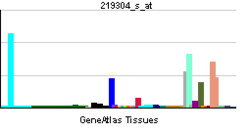- PDGFD
-
Platelet derived growth factor D Identifiers Symbols PDGFD; IEGF; MGC26867; SCDGF-B; SCDGFB External IDs OMIM: 609673 MGI: 1919035 HomoloGene: 11875 GeneCards: PDGFD Gene Gene Ontology Molecular function • growth factor activity Cellular component • Golgi membrane
• Golgi membrane
• extracellular region
• endoplasmic reticulum lumen
• membraneBiological process • regulation of peptidyl-tyrosine phosphorylation
• positive regulation of cell divisionSources: Amigo / QuickGO RNA expression pattern 

More reference expression data Orthologs Species Human Mouse Entrez 80310 71785 Ensembl ENSG00000170962 ENSMUSG00000032006 UniProt Q9GZP0 Q925I7 RefSeq (mRNA) NM_025208.4 NM_027924.2 RefSeq (protein) NP_079484.1 NP_082200.1 Location (UCSC) Chr 11:
103.78 – 104.04 MbChr 9:
6.17 – 6.38 MbPubMed search [1] [2] Platelet-derived growth factor D is a protein that in humans is encoded by the PDGFD gene.[1][2][3]
The protein encoded by this gene is a member of the platelet-derived growth factor family. The four members of this family are mitogenic factors for cells of mesenchymal origin and are characterized by a core motif of eight cysteines, seven of which are found in this factor. This gene product only forms homodimers and, therefore, does not dimerize with the other three family members. It differs from alpha and beta members of this family in having an unusual N-terminal domain, the CUB domain. Two splice variants have been identified for this gene.[3]
References
- ^ Hamada T, Ui-Tei K, Imaki J, Miyata Y (Feb 2001). "Molecular cloning of SCDGF-B, a novel growth factor homologous to SCDGF/PDGF-C/fallotein". Biochem Biophys Res Commun 280 (3): 733–7. doi:10.1006/bbrc.2000.4187. PMID 11162582.
- ^ LaRochelle WJ, Jeffers M, Corvalan JR, Jia XC, Feng X, Vanegas S, Vickroy JD, Yang XD, Chen F, Gazit G, Mayotte J, Macaluso J, Rittman B, Wu F, Dhanabal M, Herrmann J, Lichenstein HS (Apr 2002). "Platelet-derived growth factor D: tumorigenicity in mice and dysregulated expression in human cancer". Cancer Res 62 (9): 2468–73. PMID 11980634.
- ^ a b "Entrez Gene: PDGFD platelet derived growth factor D". http://www.ncbi.nlm.nih.gov/sites/entrez?Db=gene&Cmd=ShowDetailView&TermToSearch=80310.
Further reading
- Bergsten E, Uutela M, Li X, et al. (2001). "PDGF-D is a specific, protease-activated ligand for the PDGF beta-receptor". Nat. Cell Biol. 3 (5): 512–6. doi:10.1038/35074588. PMID 11331881.
- LaRochelle WJ, Jeffers M, McDonald WF, et al. (2001). "PDGF-D, a new protease-activated growth factor". Nat. Cell Biol. 3 (5): 517–21. doi:10.1038/35074593. PMID 11331882.
- Uutela M, Laurén J, Bergsten E, et al. (2001). "Chromosomal location, exon structure, and vascular expression patterns of the human PDGFC and PDGFC genes". Circulation 103 (18): 2242–7. PMID 11342471.
- Wistow G, Bernstein SL, Ray S, et al. (2002). "Expressed sequence tag analysis of adult human iris for the NEIBank Project: steroid-response factors and similarities with retinal pigment epithelium". Mol. Vis. 8: 185–95. PMID 12107412.
- Changsirikulchai S, Hudkins KL, Goodpaster TA, et al. (2003). "Platelet-derived growth factor-D expression in developing and mature human kidneys". Kidney Int. 62 (6): 2043–54. doi:10.1046/j.1523-1755.2002.00662.x. PMID 12427128.
- Strausberg RL, Feingold EA, Grouse LH, et al. (2003). "Generation and initial analysis of more than 15,000 full-length human and mouse cDNA sequences". Proc. Natl. Acad. Sci. U.S.A. 99 (26): 16899–903. doi:10.1073/pnas.242603899. PMC 139241. PMID 12477932. http://www.pubmedcentral.nih.gov/articlerender.fcgi?tool=pmcentrez&artid=139241.
- Clark HF, Gurney AL, Abaya E, et al. (2003). "The Secreted Protein Discovery Initiative (SPDI), a Large-Scale Effort to Identify Novel Human Secreted and Transmembrane Proteins: A Bioinformatics Assessment". Genome Res. 13 (10): 2265–70. doi:10.1101/gr.1293003. PMC 403697. PMID 12975309. http://www.pubmedcentral.nih.gov/articlerender.fcgi?tool=pmcentrez&artid=403697.
- Taneda S, Hudkins KL, Topouzis S, et al. (2004). "Obstructive uropathy in mice and humans: potential role for PDGF-D in the progression of tubulointerstitial injury". J. Am. Soc. Nephrol. 14 (10): 2544–55. doi:10.1097/01.ASN.0000089828.73014.C8. PMID 14514732.
- Uutela M, Wirzenius M, Paavonen K, et al. (2004). "PDGF-D induces macrophage recruitment, increased interstitial pressure, and blood vessel maturation during angiogenesis". Blood 104 (10): 3198–204. doi:10.1182/blood-2004-04-1485. PMID 15271796.
- Gerhard DS, Wagner L, Feingold EA, et al. (2004). "The Status, Quality, and Expansion of the NIH Full-Length cDNA Project: The Mammalian Gene Collection (MGC)". Genome Res. 14 (10B): 2121–7. doi:10.1101/gr.2596504. PMC 528928. PMID 15489334. http://www.pubmedcentral.nih.gov/articlerender.fcgi?tool=pmcentrez&artid=528928.
- Ray S, Gao C, Wyatt K, et al. (2005). "Platelet-derived growth factor D, tissue-specific expression in the eye, and a key role in control of lens epithelial cell proliferation". J. Biol. Chem. 280 (9): 8494–502. doi:10.1074/jbc.M413570200. PMID 15611105.
- Ustach CV, Kim HR (2005). "Platelet-Derived Growth Factor D Is Activated by Urokinase Plasminogen Activator in Prostate Carcinoma Cells". Mol. Cell. Biol. 25 (14): 6279–88. doi:10.1128/MCB.25.14.6279-6288.2005. PMC 1168822. PMID 15988036. http://www.pubmedcentral.nih.gov/articlerender.fcgi?tool=pmcentrez&artid=1168822.
- Liu MY, Eyries M, Zhang C, et al. (2006). "Inducible platelet-derived growth factor D-chain expression by angiotensin II and hydrogen peroxide involves transcriptional regulation by Ets-1 and Sp1". Blood 107 (6): 2322–9. doi:10.1182/blood-2005-06-2377. PMID 16189269.
Growth factors Fibroblast EGF-like domain TGFβ pathway Insulin-like Platelet-derived Vascular endothelial Other B trdu: iter (nrpl/grfl/cytl/horl), csrc (lgic, enzr, gprc, igsr, intg, nrpr/grfr/cytr), itra (adap, gbpr, mapk), calc, lipd; path (hedp, wntp, tgfp+mapp, notp, jakp, fsap, hipp, tlrp) Categories:- Human proteins
- Chromosome 11 gene stubs
Wikimedia Foundation. 2010.
